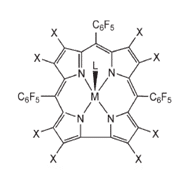
CoIII Corrole as a Potential Catalyst for Oxygen Reduction in Fuel Cells
The projected limited supply of energy is one of the biggest problems of this century. In recent years, with an increase in global population density, we see a surge in pollution and a concomitant damage to the natural environment.1 Without a doubt, an alternative way to produce energy must be developed. One of the most promising renewable energy technologies today is fuel cells.2 Fuel cells are devices that convert chemical energy to electrical energy by redox reactions that occur at the anode and cathode. Currently, the most efficient and popular catalyst in fuel cells is Pt, which is a scarce and expensive metal.
In order to design alternative fuel cell cathodes, the current research examines potential bio-inspired oxygen reduction catalysts for fuel cells. Specifically, we focus on metallocorrole derivatives that modulate the extent of catalytic activity.3 In the current work we studied CoIII corroles containing meso substituents with different electronegativity (Figure 1).4 We investigate the corroles by performing electrochemical measurements, as well as atomistic density functional theory calculations to estimate their stability and electronic structure. We identify factors that affect the catalytic activity and in particular the role of substituents with different electronegativity.

Figure 1. A metallocorrole with its substituents- C6F5 as meso, X as β and L as an axial ligand.
References
[1] Adrian Cho Science, 2010, 329 (5993), 786-787.
[2] Yun Wang, Ken S Chen, Jeffrey Mishler, Sung Chan Cho and Xavier Cordobes Adroher Appl. Energy, 2011, 88 (4), 981-1007.
[3] (a) Naomi Levy, Atif Mahammed, Ariel Friedman, Bar Gavriel, Zeev Gross and Lior Elbaz ChemCatChem, 2016, 8, 2832-2837. (b) Naomi Levy, Atif Mahammed, Monica Kosa, Dan T Major, Zeev Gross and Lior Elbaz Angew. Chem. Int. Ed. 2015, 2015, 54 (47), 14080-14084. (c) Atif Mahammed, Biswajit Mondal, Atanu Rana, Abhishek Dey and Zeev Gross Chem. Commun., 2014, 50 (21), 2725-2727.
[4] Iris Aviv and Zeev Gross Chem. Commun., 2007, (20), 1987-1999.

Powered by Eventact EMS